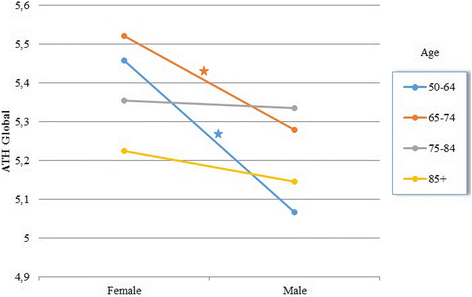The role of gender in the active attitude toward treatment and health among older patients in primary health care-self-assessed health status and sociodemographic factors as moderators
- PMID: 29216837
- PMCID: PMC5721697
- DOI: 10.1186/s12877-017-0677-z
The role of gender in the active attitude toward treatment and health among older patients in primary health care-self-assessed health status and sociodemographic factors as moderators
Abstract
Background: Active attitude toward treatment and health (ATH) leads to improved cooperation and better health outcomes in patients. Supporting it in the population of older adults is a growing need in primary care. Recognising the role of gender, health and other sociodemographic factors can help to distinguish patients who need the most assistance in activation from general practitioners (GPs). The objective of the study was to investigate gender differences in ATH as well as the moderating role of self-assessed health (SAH) and selected sociodemographic factors (age, education, financial status, marital status).
Methods: A cross-sectional, multicentre study among 4936 primary care older patients (aged 50+) was conducted. The PRACTA-Attitude toward Treatment and Health questionnaire (PRACTA-ATH) was used to measure the cognitive, emotional (positive and negative affect), and motivational dimensions of ATH. Patients were approached before and after their visits in the primary health-care facilities randomly selected in Central Poland.
Results: Generalised linear models (GENLIN) revealed the main effects of gender, SAH, and sociodemographic characteristics, such as financial status, marital status and education. Interaction effects of gender and age (Wald's χ2 = 24.767, p < 0.001 for ATH Global), as well as gender and SAH (Wald's χ2 = 16.712, p < 0.002 for ATH Global) on ATH were found. The most assistance in regard to ATH was required by men aged 50-74 and men declaring good self-assessed health. Generally, women declared a more active attitude than men, showing more knowledge (M = 5.40, SD = 0.07 and M = 5.21, SD = 0.07, for women and men, respectively, p = 0.046), positive emotion (M = 5.55, SD = 0.06 and M = 5.33, SD =0.06, for women and men, respectively, p = 0.015) and motivation to be involved in their health issues (M = 5.71, SD = 0.07 and M = 5.39, SD = 0.07, for women and men, respectively, p = 0.001). The level of negative emotions related to health was not significantly different between genders (p = 0.971).
Conclusions: The need to create health promoting programmes taking account of particular gender differences in older adults emerges. In regard to clinical practice, building a sense of efficacy and individual responsibility for health, providing information about the means of health promotion and prevention, and recognising health-related cognitions, is recommended especially for men who feel well and are less advanced in age (50-74).
Keywords: Ageing; Gender; Health promotion; Men’s health; Patient adherence.
Conflict of interest statement
Ethics approval and consent to participate
The study was approved by the Bioethics Committee of the Medical University of Warsaw (Ref.no KB/10/2014). Written informed consent was granted from all participants in the study.
Competing interests
The authors declare that they have no competing interests.
Publisher’s Note
Springer Nature remains neutral with regard to jurisdictional claims in published maps and institutional affiliations.
Figures
References
-
- World Health Organization. Good health adds life to years. Global brief for world health day 2012. 2012. http://www.who.int/ageing/publications/whd2012_global_brief/en/. Accessed 10 Feb 2016.
-
- Thompson TL, Robinson JD, Beisecker AE: The older patient-physician interaction.In Handbook of communication and aging research. Edited by Nussbaum JF, Coupland J. Mahwah. NJ: Lawrence Erlbaum Associates; 2004:451–577.
Publication types
MeSH terms
Grants and funding
LinkOut - more resources
Full Text Sources
Other Literature Sources



